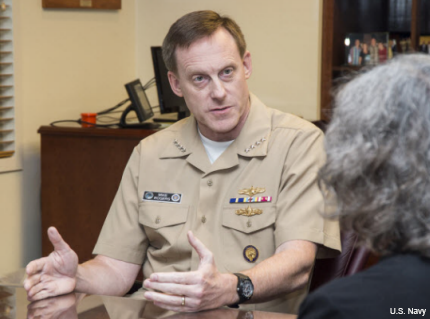For DOD, building the cyber force is a team game
The cyber force is only halfway towards its personnel goal, but members are making marginal strides in training, recruitment and defining roles in the emerging operational domain.

U.S. Cyber Commander Adm. Mike Rogers says the command needs multiple types of teams to handle multiple missions.
The Defense Department is still in the relatively nascent stages of building its cyber mission force, but it has made some progress in recruitment, training and defining roles. In Some ways, it has come down to team building.
According to Adm. Mike Rogers, commander of U.S. Cyber Command, the command has three primary missions: 1) defend DOD networks; 2) generate the cyber mission force and deploy it across the department with a range of defensive and offense capabilities; and 3) “If directed by the president or the secretary [of Defense] … defend critical U.S. cyber infrastructure from significant cyber intrusion,” he said last week at the Aspen Security Summit.
“To do those three missions…we came to the conclusion that to execute those missions, you needed – just like any other missions we have in the military – you needed trained men and women, who were organized in the units to execute the mission, so we came up with this idea of teams,” Rogers said. “And we decided that because we have multiple missions, we needed multiple kinds of teams.”
In line with the command’s mission, it has defines three basic types of teams. “One kind is focused on defending networks, one type of team is focused on supporting combatant commanders around the world – Pacific Command, Central Command – and helping to use cyber as a tool to generate more options to support them in their operational objectives, and the third kind of team we created is to defend that critical cyber infrastructure from significant cyber intrusion,” he said.
Each of the military services also have their own cyber commands, which are undergoing similar development. During a week-long hackathon last week sponsored by the Defense Advanced Research Projects Agency’s Plan X, Army Capt. Justin Lanahan said that the Army is still defining its work and the roles of cyber officers, though he noted that the future does look promising.
“At minimum, the cyber mission force is going to be the primary unit we operate in," Lanahan said. "We'll be bouncing between the tactical-level cyber mission force, and the strategic-level at the actual service component headquarters or U.S. Cyber Command. So the work roles would look like an operational planning team leader or a mission commander."
Lanahan said that part of shaping the Army’s cyber force is understanding the difference between combat operations and supporting combat operations. He noted that computers, networks and radios used to be viewed as supporting combat missions, which is no longer the case. "Cyber isn't just an enabling mission for the kinetic mission," he said. "Cyber can be an effect unto itself, not just enabling some other kinetic action."
Another role that Army commanders are interested in is conceptualizing and translating the wonky and technical language associated with cyber into more familiar language that commanders with more traditional kinetic backgrounds can understand. "One of the things we bring is, aside from a love for technology, the ability to translate between military science and computer science," Capt. James McColl said during the Plan X hackathon. "The Army is primarily relying on us to be able to bring cyber effects into the fight. If you think about maneuver elements like infantry and artillery, they are delivering direct or indirect fire effects to a target. For us, we are trying to translate to those kinetic leaders how to use cyber effects to augment their mission. In a situation where dropping a Joint Direct Attack Munition on a building isn't necessarily the best option, we offer an alternative."
The Air Force also is trying to spread the word on cyber with the establishment of the Task Force Cyber Secure. The task force, which has counterparts in other service branches, seeks to “address challenges of the cyberspace domain in synchronization, operations and governance within the Air Force and with those organizations it supports.”
As part of this effort, the Air Force is attempting to bolster partnerships with both academia and industry, specifically Silicon Valley. "We should mimic the companies in Silicon Valley by increasing agility in our acquisition and procurement processes, accepting risk, failing fast and quickly learning from our failures,” said Lt. Gen. Bill Bender, Air Force CIO. “The Air Force information technology community needs to adapt to this agile mindset, and quickly. The alternative costs precious time and money -- two resources which we are really short on."
On the academic side, the Air Force has worked toward the establishment of the Air Force Cyber Innovation Center to engender more “cyber-oriented airmen” through professional development.
For young officers such as Lanahan and McColl, who both graduated from the U.S. Military Academy in 2011, the establishment of cyber teams and doctrines is exciting, akin to the pioneers of military aviation. “It's like back when airplanes just came out… First you're trying to figure out what you can do with an airplane. It can only fly for 15 minutes, maybe. Then later it flies for 30 minutes... and then it flies faster,” McColl said. “With cyber, we're on that driving edge of how to make it better and make it do things to improve the way we fight.”
Rogers said that the military gave itself about three years – from fiscal 2013 to fiscal 2016 – to stand up a full cyber force with roughly 6,200 members in 133 teams. DOD is about halfway there, although Rogers said teams operating in the first category – defending DOD networks – are currently deployed around the world.
NEXT STORY: Survey: Shadow IT haunts DOD networks